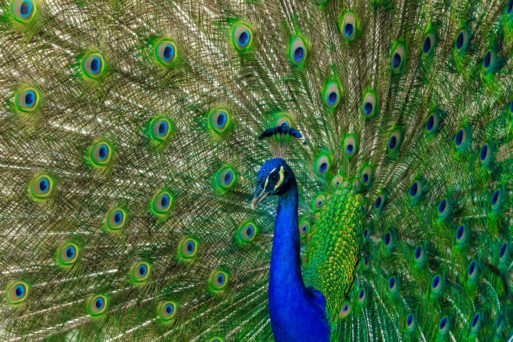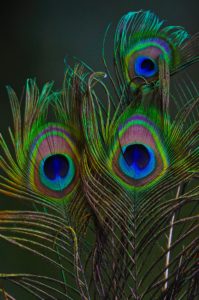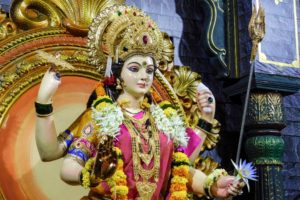
A male peacock loses his feathers and regrows them longer each and every year.
When a majestic male peacock fans his feathers and struts his stuff, we take notice. Peacocks exude an air of confidence; they are true to themselves. Some cultures revere these majestic birds as a good omen, believing they bare prophetic significance. Their images are strongly associated with Gods, royalty and immortality.

Hindus believe peacock feathers bring good luck and protection. Many families in India keep some inside their homes.
Aside from domestication in some areas of the world, peacocks are predominantly found in forests in Africa and Asian territories. Male peacocks boast 200 colorful and nearly iridescent feathers. They molt, or shed, and regrow their feathers every year in young adult life. The female of this species is called a peahen. Her feathers are not as formidable as the male. He uses his stature solely to impress her in a courtship dance each mating season.
The peacock is symbolic in many religious and cultural beliefs. In Asian culture, the peacock is associated with the goddess Kwan-yin. She is a beloved goddess of mercy, or healing, adorning many altars throughout China. It is believed her image evokes compassion and love. And Christians view peacocks as a symbol of resurrection and eternal life. Spiritualdirection.com notes that many religious artists use their regal images as a metaphor for new life, renewal or rebirth.

A royal depiction is adorned with peacock-like
colors at Durga Devi temple in Mumbai, India
during the festival of Navratri in 2018.
India honors the peacock as its national bird. Its likeness is used to depict many gods and goddesses in Hinduism, the most popular religion in their country. The peacock is strongly associated with Lakshmi, one of the principal goddesses in Hinduism. Lakshmi is the goddess of prosperity, power, fertility, and fortune. The vibrant colors of the peacock are often utilized in royal depictions and adornments as a sign of sovereignty.
Some people believe that seeing certain animals or birds, particularly in odd places or dreams, conveys a spiritual meaning. Perhaps they may even be considered as your spirit animal or guide. The appearance of a peacock could be encouraging you to show your true colors. Its meaning can vary across cultures to include messages of self-love, patience, benevolence, compassion, good-will, and kind-heartedness. Whatever their message, peacocks can be powerful omens.

The appearance of a peacock, or peahen, may carry a spiritual message or meaning for some.
In July 2021, an elderly Hindu woman arrived at a hospice in-patient unit where I worked. The facility is located within a hospital complex in a dense suburban area. Within hours of her arrival, a beautiful peahen appeared in the courtyard. Her family members were astounded by its presence, as their loved one had a peacock tattoo emblazoned on her chest. She considered the bird to be her totem guide.
No one could ever figure out where the bird came from. There are no farms or zoos near the premises. But on the day the woman died, the peahen disappeared, never to return. The family views its appearance as a testament to their loved one’s eternal life.
The peacock is often equated to the Phoenix, a mythical immortal bird that rises from the funeral pyre ash to be reborn. They are a reminder to shed the old, so we can make way for the new. This can be likened to life and death. I like to think that the Hindu woman arose to spread her majestic wings in solemn grandeur in whatever afterlife awaited her.
You can read about the peacock’s spiritual meaning and learn more about other spirit animals and birds here.

 Peacocks Symbolize Rebirth and Renewal
Peacocks Symbolize Rebirth and Renewal


 First the Wealth Gap, Now the U.S. Has a Growing Health Gap
First the Wealth Gap, Now the U.S. Has a Growing Health Gap
 How to Comfort A Dying Loved One
How to Comfort A Dying Loved One
 Our Annual Seven Holiday Gifts for Someone Who Is Grieving, 2024 Edition
Our Annual Seven Holiday Gifts for Someone Who Is Grieving, 2024 Edition














